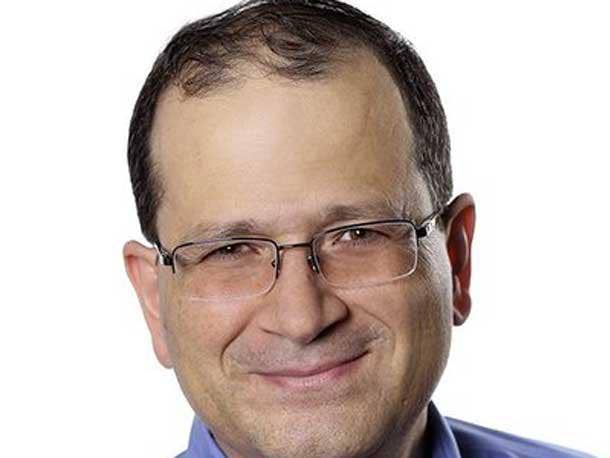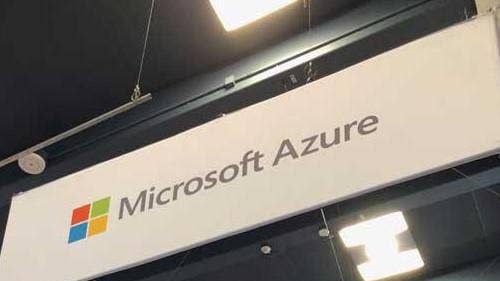Microsoft Azure Networking Exec Yousef Khalidi On ‘Building Our Telecommunications DNA’
‘Both on the private MEC and the public MEC, there is definitely a need for the partner ecosystem beyond the ISVs,’ Yousef Khalidi tells CRN. ‘Some of these solutions require a certain amount of integration that only partners can really get to get done.’

Yousef Khalidi, Microsoft’s chief vice president of Azure networking, told CRN in an interview that partners will serve an important role in Microsoft and operators such as AT&T bringing new edge and 5G products to market.
Microsoft announced a host of updates to its 5G and edge products suite this week – including expanded access to Azure public multi-access edge compute (MEC) – during the MWC Barcelona mobile communications trade show.
MWC, also known as Mobile World Congress, is held in Barcelona in person this year from Feb. 28 to March 3.
“Both on the private MEC and the public MEC, there is definitely a need for the partner ecosystem beyond the” independent software vendors (ISVs),” Khalidi said in a phone interview. “Some of these solutions require a certain amount of integration that only partners can really get to get done.”
[RELATED: 5 Things Partners Need To Know About The Microsoft- AT&T 5G Deal]
Accenture, Atos, Capgemini, Cognizant, Tata Consultancy Services (TCS) and Tech Mahindra are among the global system integrators working with Microsoft on 5G offerings, according to the Redmond, Wash.-based tech giant.
The competition over cloud-enabled 5G and edge technologies appears to be heating up between the major cloud providers, with Microsoft and cloud rivals Amazon Web Services (AWS) and Google Cloud.
Both Microsoft and AWS have made major investments in growing their telecommunications offerings. AWS is participating in multiple sessions around 5G and cloud at MWC Barcelona. AWS CEO Adam Selipsky has told CRN that telecommunications is a vertical of interest. Selipsky will deliver a keynote address during MWC March 1.
Both companies have partnered with Verizon on public and private mobile edge computing. In April, AWS and Verizon announced a private multi-access computing (MEC) for enterprises.
Last summer, Microsoft and AT&T reached a deal that brings the carrier’s 5G workloads to the Azure for Operators platform and gives AT&T access to Microsoft cloud, artificial intelligence and edge technology to assist with launching new 5G-enabled services.
In November, AWS announced a preview of its private 5G managed service offering.
AT&T and Google, widely regarded as the No. 3 cloud behind AWS and Microsoft, also announced joint 5G and edge offerings last year.
Here’s what Khalidi had to say about Microsoft diving deeper into 5G and edge.

How has Microsoft been building its networking offerings with Azure?
We’ve been building the public cloud since 2006. Yours truly was actually one of the founders of the initial Azure platform. It’s been a long journey, in which we had to build from scratch and now we are one of the biggest public clouds on the face of the earth meeting enterprise needs.
You name it, it runs on Azure, from banking, mission-critical applications, all the way down to marketing, what have you.
A few years ago, we decided that we have a very important partner segment here, which is the telecommunication industry, that we were not meeting the needs for their core network workloads.
We have always been working with the likes of AT&T on their back-office infrastructure and the like. But when it came to the core business, the core network workloads, none of the public cloud providers were meeting the needs.
So we embarked on a strategy to basically combine what we know best of hyperscale, strong networking technology and so forth, with the demanding needs of the telecommunications industry.
They need carrier-grade quality, to be the hybrid model and so forth. We also noticed that they are under pressure. They need to be more agile in their infrastructure, in their business. They need to be able to future proof that technology investments, especially with 5G build outs. And they need to monetize the networks. And we figured that we can partner with them and their ecosystem to basically go on a similar journey like we did for the public cloud, but now in a hybrid model that meets their core business needs and core networking workloads. … As part of this journey, we have been building our telecommunications DNA.
We went through a number of acquisitions, we brought in industry leaders, some folks like yours truly became more knowledgeable in the space. We are still very humble though. It’s all about us partnering with the partner ecosystem both the operators themselves and the ecosystem. And the ecosystem is quite broad from network equipment providers to software vendors and so forth.
Last year, one of the acquisitions we made was a deal with AT&T, in which AT&T agreed for us to acquire their network cloud platform, including their personnel and the basic infrastructure that underlines all of AT&T’s mobile networks.
So my 5G handset in my hand at the moment, which is AT&T networks, runs basically on a platform that we are now responsible for. It also runs first-party workloads plus more than a dozen other vendors’ software.

What’s this platform for operators Microsoft will announce at MWC?
What we’re announcing at MWC (Mobile World Congress) is that we will be building a platform … that will be available for every operator out there – starting with AT&T but for everybody else – that combines the power of Azure, the hybrid model, the network cloud assets we got, plus a partner ecosystem that includes virtually anybody that really matters as far as workloads are concerned.
So it’s very much a hybrid model that meets operators where they are today. So it will work in brownfield deployments plus greenfield deployments. Our strategy is to meet operators where they are today.
We are not starting with a small operator, we’re starting with one of the biggest on the face of the earth, AT&T. It’s a hybrid model. That means the public cloud will be used for management functions, control functions, huge AI (artificial intelligence), ML (machine learning) jobs and the like.
But the core workloads will run very close to where the users are, on the so-called near edge.
And that means we can go and meet their needs today. We’re allowing them to use more and more cloud technologies.
Azure, we have a strong portfolio when it comes to management orchestration and so forth. And we’ll apply all of these to have a very fragile, highly automated system that, still, is operated and run by the operator. That’s very important. The place of control remains with the operator.
We are a platform. We are very good plumbers. We provide automated plumbing, if you will – but customer, the service, everything is owned by the operator. I want to be extremely clear.
It’s very much a partner-led ecosystem play. The platform will run tens of different functions, whatever the customer wants.
So if you want this to work with network X and Y, it’s part of the platform. … It will be rolled out later this year into the next year. … Internally, we call it Azure Network Cloud. … Our goals for operators were to meet their core network workloads, agility and technology profile. And that’s what this platform gives you.
But there’s also another need they have, which is how to monetize some of the 5G investments.
And for that, we are now extending Azure compute capabilities into the network. Previously, we announced a private MEC (multi-access edge compute) offer, which is basically the ability for an enterprise or an operator to deploy hardware boxes run by Azure that combines private networking and computation.
And those uses were for, for example, in factory floors. … So public MEC is a new solution of something we had before called network edge but with operators. Essentially, it combines Azure computation with the operators’ 5G network.
So it’s ability to place latency-sensitive computation that has to be highly integrated with the 5G networks. … We’re going to show some application suites, ISVs (independent software vendors) and some scenarios where this is really needed … There are a set of applications up and coming – think of virtual reality, augmented reality, IoT (internet of things) scenarios – where there is a low-latency component plus the rest of the stuff.
So in our model, a developer has the ability to put components very close to the 5G network, either on-premises with the private MEC or at the edge with the operator with the public MEC and leave the rest of the stuff that requires high levels of scale for the public MEC.
And the beauty of the model is it’s the same management model, same way to do logging, monitoring, deployment, lifecycle management, policy management, security, etcetera.

Will partners play an important role in bringing these products to market?
Both on the private MEC and the public MEC, there is definitely a need for the partner ecosystem beyond the ISVs.
Because some of these solutions require a certain amount of integration that only partners can really get to get done.
So for the private MEC, for example, you still need to have local radios on the factory floor and a high level of integration for the software. For the public MEC, similarly for the software integration, we and the operator do all the heavy lifting in terms of the network integration, what have you.
But then what? The workloads have to come from the partner ecosystem. We see – from small ISVs to integrators, to specialized integrators who do things like radio and the like – to be a very important part of the ecosystem here.
For the platform, it’s typically the major SIs (systems integrators) who typically have the ability to help with the bigger platform components.
The interesting thing is, frankly, the use-case scenarios are popping up left and right … multiple examples of both big companies and small companies partnering with us and the operators on doing the solutions. So it’s an exciting area.
Some more mechanical things to get done, plus new opportunities … We want to make it easier, faster, more agile for the operators, but we want to enable everybody to make money out of infrastructure, too.

What’s your advice to partners that want to invest in growing in this area with you?
There is a hands-on component to all of these things. So if the partner is not familiar with the ecosystem for a given area, for a private MEC or a public MEC, they need to get to know the technologies.
The beauty of our model … if they know Azure, they are 90 percent of the way there. It is a bit of a simplification, but if you know how to use Azure, if you understand the management model, lifecycle management and the like, many of the principles apply here.
So software integration for these solutions starts with the Azure model, if you will.
Even the deployment model can be on-prem or on the edge. … We are not just putting (out) a bunch of boxes and wires and saying, ‘Hey, go figure it out.’
So I would start with Azure. And if you’re a partner somewhere in the ecosystem, and you understand Azure, you are quite some ways into the solution set already.
The other thing you have to know, depending on the specialization, if you’re doing radios versus some other aspects of connectivity, you need to know those things as well.
Sounds like partners of AT&T, for example, can come in through what they are comfortable with?
Indeed. I have to tell you, for example, AT&T and us have been working together on Azure for multiple years.
I want to be honest with you as well. When it comes to core networks, though, the bar is higher as carrier grade. So you use the expertise you have and then move on from there.

What do you view as the obstacles to MEC growing in use?
The big challenge, I’ll be honest with you, everybody who wants to be in this space has to be agile, has to be fast, has to be quick to adjust and to learn.
This is not business as usual. This is not taking technology that was built 10 years ago and deploying it. … Our strategy is very much built on having a vibrant ecosystem, a partner ecosystem, because solution sets will come from the ecosystem. Not from one person or entity.
What use cases have you excited so far?
But they typically end up in areas where you need very low latency or you need something to be close to the user. … Many of the examples are going to be either manufacturing, IoT. Eventually we’re going to see some gaming. … And there are two aspects of latency here, not to get too detailed, but one is to be closer to the user, but also because we integrate very closely to the operator 5G network.
Is labor shortage an obstacle? Or do current skills meet the demand?
There’s a lot of demand for folks who understand the cloud who can innovate in this space. There’s a lot of smart people in the industry, and we need more of them to know the cloud.
As I said earlier, if you know the cloud, you can really enter these new, adjacent areas.

What’s the timeline for rolling out these products?
For the public MEC, it is already up and running in a bunch of customers … For the platform, the network cloud platform, the earlier version of it is already out with AT&T. The new version, which is the public one, will be rolled out later this year and early next year.
Tell me more about how partners can get involved.
I really meant it when I said we are plumbers, OK. And I’m proud of it.
The solutions to any of the pieces I mentioned to you – the network cloud, the private and public MEC – they will require the partner ecosystem and require the software ecosystem.
So we are a platform company that depends on, that encourages ecosystems, to get solutions done. We are not saying it’s a one shop that does everything. It doesn’t work this way.
For example, the network cloud platform runs components, workloads from more than a dozen vendors out there. And the number of entities that can use it is much bigger than that.
All these things can require work from the partner ecosystem to do integration work and so forth.
So even for that one, which is toward the lowest part of the stack, requires work. And when it comes to things like the public MEC and the software for it and the private MEC, other skills are needed, from Software Development to deployment services and so forth. So this doesn’t fly without the partner ecosystem.
What can you tell me about security and these products?
On the public cloud today, we run some of the biggest banks and financial institutions in the world on the cloud.
And our No. 1 priority – No. 2 and three – is security. Before speeds or costs. So that’s a core part of our DNA.
The same way I said the cloud principles apply to everything we do here, it’s the same thing when it comes to security. And I mentioned earlier policy, for example – how you control the resources and compliance. The beauty of using the investments we have for things like security, compliance, policy management and availability and blah, blah, blah – all this applies here as well.

How will we see these products evolve after they are released?
For the platform component, network cloud, the lowest part – I see a lot of automation and cost cutting and passing that cost savings to the operators.
And I see them having a lot more agility and choice in choosing the underlying hardware because we work with the partner system on hardware as well.
So it’s more on the agility part and the choice part and hopefully getting some of the cost – which today is sometimes being spent on mundane tasks – out of the way.
For the MEC, be it public or private, I see a more vibrant ISV and the developer ecosystem. Part of the job is on us to make sure that the platform is easy to program and to use and to manage but also on the ecosystem to really come up with new scenarios for usage – from the specialized ones, maybe like IoT and factory automation, to even retail and shops and what have you.
It’s really more about maturity, agility and having a lot more applications.
Will we see more vendor partnerships from Microsoft over time?
We are clear on where we have to innovate. As I mentioned, more on the platform level – make it easier, more secure, easy to program.
Operators know the need to be more agile and they need monetization options. And the partner ecosystem will be presented with many opportunities to innovate in these new areas.